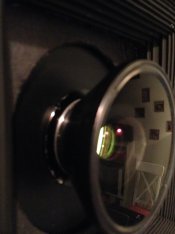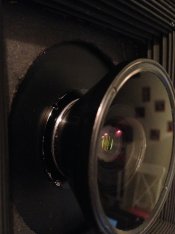The usual starting point is the lens maker’s stated image circle diameter at a given aperture. If we know the specific lens name, focal length and aperture we can usually find the lens maker’s stated image circle diameter at a given aperture with an Internet search.
When we view to compose and focus a lens we generally do so with the aperture fully open for the brightest view. The full-diameter illuminated circular projection has usable definition in the central part of the circle, but is too poor for practical use further outward radially with the aperture at its largest setting.
The aperture must be closed to a smaller size to expand the circle of good definition to a larger portion of the projected circle. The practical infinity-focus image circle is generally given at f/22 for large-format lenses but might be given at f/16 for some 4” x 5” format wide-angle lenses.
Here’s how Nikon states this for its large-format lenses.
Nikkor-W 210mm f5.6
Focal length 210mm
Maximum aperture ratio 1:5.6
Minimum aperture f/64
Lens construction 6 elements in 4 groups
Covering power (f/5.6) 60°
Covering power (f/22) 70°
Image circle (f/5.6) 243mmφ
Image circle (f/22) 293mmφ (6 1/2” x 8 1/2”)
Nikkor-SW 75mm f4.5S
Focal length 75mm
Maximum aperture ratio 1:4.5
Minimum aperture f/45
Lens construction 7 elements in 4 groups
Covering power (f/4.5) 80°
Covering power (f/16) 106°
Image circle (f/4.5) 126mmφ
Image circle (f/16) 200mmφ (120mm x 165mm)
Schneider lists the available axis shifts for its large-format lenses here in the table titled “Angle of View, Image Circles, and Lens Displacements."
https://www.schneideroptics.com/pdfs/photo/LensCharts.pdf
For lenses for which we know the infinity image circle diameter at the given aperture, but for which we can’t find the lens displacement tables, we can calculate the maximum shift from the neutral (lens centered over film) position.
Available Shift Based on Image Circle and Format Dimensions
I = lens maker’s stated infinity-focus image circle diameter at a stated aperture
C = chord length (format dimension touching image circle at limit of movement)
A = shifted-axis format dimension perpendicular to C
Axis shift = ( SQRT(I^2 – C^2) – A)/2
For example, for the 75/4.5 Nikkor SW at f/16 I = 200mm. Suppose you had the long dimension of the 4” x 5” film oriented vertically and you want to shift upwards to capture the tops of some tall trees. Assume that you start with the lens centered over the view screen. How far could you raise the lens board upward and keep the corners inside or just touching the image circle?
The image area on a 4” x 5” film is about 95mm x 120mm.
So I = 200mm, C = 95mm, A = 120mm
Long-axis shift = (SQRT((200mm)^2 – (95mm)^2) – 120mm)/2 = 28mm
Short-axis shift = (SQRT((200mm)^2 – (120mm)^2) – 95mm)/2 = 32.5mm
For a 6.9/90 Super Angulon with I = 216mm at f/22 we get
Long-axis shift = 37mm
Short-axis shift = 42mm
which agrees with entries in the the Schneider Lens Displacement Table for this lens.





